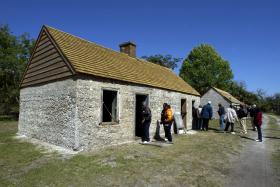History: At the meeting between the Creeks and the Georgia colonists a "Treaty of Friendship and Commerce," was signed. The treaty acknowledged Native American ownership of all lands "as high up as the tide flows" between the Savannah and Altamaha Rivers and allowed the Europeans free right and title to the lands they occupied. The Creeks reserved the rights to use the barrier islands of Ossebaw, Sapelo and St. Catherines for hunting, bathing and fishing.
And I looked up at the mound and asked, where did all deez flat feets go because we sure is black and I know day aint with those white folks us der at the tree.
Monday, April 4, 2011
Saturday, February 26, 2011
February 26 Harris Neck Festival
Storytellers, shouters and others will perform at the annual Harris Neck Festival 10 a.m. to 5 p.m. Feb. 26 on the grounds of the First African Missionary Baptist Church of Harris Neck in northern McIntosh County.
Sponsored by the Harris Neck Land Trust, the festival will feature performances by the Gospel Messengers and the Gullah Geechee Shouters, storytelling by Jamal Toure and food sales.
The land trust will also give an update on the Harris Neck Justice Movement, an effort to reclaim land taken by the federal government through eminent domain during World War II.
The government built an airfield on the land but deeded it to the county for public use after the war. After the county allowed the land to be misused, the federal government took it back and the U.S. Fish and Wildlife Service now operates it as Harris Neck National Wildlife Refuge. The refuge provides important habitat for migratory birds, including wood storks.
The Land Trust represents former residents and descendants of former residents of the disputed property. They contend the federal government promised the property would be returned at the end of the war, but never followed through.
The group is trying to influence Congress to enact legislation returning the property to the original owners. The land was settled by freed slaves at the end of the Civil War. They and their descendants lived there until the federal government bought the property.
The church is on Harris Neck Road, about five miles east of U.S.17 in northern McIntosh County. Harris Neck Road and U.S. 17 intersect a mile south of Exit 67 off Interstate 95.
Read more at Jacksonville.com: http://jacksonville.com/news/georgia/2011-02-01/story/harris-neck-land-issue-part-feb-26-festival#ixzz1F4spWCtk
Sponsored by the Harris Neck Land Trust, the festival will feature performances by the Gospel Messengers and the Gullah Geechee Shouters, storytelling by Jamal Toure and food sales.
The land trust will also give an update on the Harris Neck Justice Movement, an effort to reclaim land taken by the federal government through eminent domain during World War II.
The government built an airfield on the land but deeded it to the county for public use after the war. After the county allowed the land to be misused, the federal government took it back and the U.S. Fish and Wildlife Service now operates it as Harris Neck National Wildlife Refuge. The refuge provides important habitat for migratory birds, including wood storks.
The Land Trust represents former residents and descendants of former residents of the disputed property. They contend the federal government promised the property would be returned at the end of the war, but never followed through.
The group is trying to influence Congress to enact legislation returning the property to the original owners. The land was settled by freed slaves at the end of the Civil War. They and their descendants lived there until the federal government bought the property.
The church is on Harris Neck Road, about five miles east of U.S.17 in northern McIntosh County. Harris Neck Road and U.S. 17 intersect a mile south of Exit 67 off Interstate 95.
Read more at Jacksonville.com: http://jacksonville.com/news/georgia/2011-02-01/story/harris-neck-land-issue-part-feb-26-festival#ixzz1F4spWCtk
Thursday, February 3, 2011
Gunha Speaks
And Addy asked Gunha, Why are my people crying?Why we dying?And she said because mes people forgotsa their soul and de food and de ways of de old and day forgot to grown their own.
Saturday, September 11, 2010
Little known facts Mitchelville
"One of the places they settled was Mitchelville, established by Maj. Gen. Ormsby M. Mitchel. He set aside about 1,000 acres, and in 1863 started selling it off. It went for about $1 an acre. People saved money to buy land because they knew land meant freedom," explains Campbell as he drives his small bus toward Mitchelville. This was the country's first settlement of Freedmen (former black slaves), and its founding came before President Abraham Lincoln's Emancipation Proclamation. Residents elected their own officials. The town council passed laws, including the state's first compulsory-education law.
The U.S. government abandoned this fledgling community in 1868 because President Andrew Johnson was "very sympathetic with the Confederates," Campbell says.
After the Civil War, many former slaves remained on Hilton Head and on other South Carolina islands, such as Johns and Daufuskie, and Georgia 's Sapelo, Harris Neck and Cumberland . They fished and farmed. They operated sugarcane mills and gristmills. They grazed their livestock and hunted on the open, common land.
The U.S. government abandoned this fledgling community in 1868 because President Andrew Johnson was "very sympathetic with the Confederates," Campbell says.
After the Civil War, many former slaves remained on Hilton Head and on other South Carolina islands, such as Johns and Daufuskie, and Georgia 's Sapelo, Harris Neck and Cumberland . They fished and farmed. They operated sugarcane mills and gristmills. They grazed their livestock and hunted on the open, common land.
Subscribe to:
Posts (Atom)
